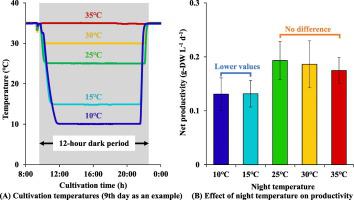Algal Research ( IF 5.1 ) Pub Date : 2020-11-21 , DOI: 10.1016/j.algal.2020.102132 Kenji Tanaka , Masatoshi Kishi , Hirut Assaye , Tatsuki Toda

|
Heating cost during the night is a problem in outdoor cultivation of a cyanobacterium Arthrospira platensis. Low night temperature causes decreased biomass productivity during daytime and biomass loss during night, but there are few studies to fully investigate these impacts at the same time. To evaluate the effect of dark-period temperature (10–35 °C) on the net productivity (g-DW L−1 d−1) of Arthrospira platensis, semi-continuous cultivations were conducted in 1-L cylindrical glass photobioreactors with an LD cycle of 12-hour light and 12-hour dark under a light-period temperature of 35 °C and dark-period temperatures between 10 and 35 °C. By monitoring at 12-hour intervals, daytime productivity (g-DW L−1 d−1) and night biomass loss (%biomass) were investigated to understand net productivity. There was no significant difference in the net productivity and daytime productivity at high dark-period temperatures (25, 30 and 35 °C). On the other hand, at lower dark-period temperatures (10 and 15 °C), the net productivity and daytime productivity were at most 30% lower than that recorded at higher temperatures (25 and 30 °C). The dark-period temperatures were negatively correlated with carbon to nitrogen (C:N) ratio and positively correlated with dark-respiration rates, which suggested low protein synthesis at low dark-period temperature leading to the low net productivity at 10 and 15 °C. The tolerance of Arthrospira platensis to low dark-period temperature (25 °C) indicates possible cost reduction to control temperature during dark period. This study clarified that the low night temperature reduced net productivity of microalgae and cyanobacteria, and night temperature should be managed in outdoor cultivation based on the permissible dark-period temperature range.
中文翻译:

暗期低温影响蓝藻节肢动物的生物量生产力
夜间取暖费用是蓝藻Arthrospira platensis的室外栽培中的一个问题。夜间温度低会导致白天的生物量生产力下降,夜间的生物量损失减少,但是很少有研究能够同时全面研究这些影响。为了评估暗温(10–35°C)对Arthrospira platensis的净生产力(g-DW L -1 d -1)的影响,我们在带有1L圆柱形玻璃光生物反应器的条件下进行了半连续培养。在35°C的亮期温度和10至35°C的暗期温度下,LD周期为12小时亮暗12小时。通过每隔12小时进行监视,白天的生产率(g-DW L -1研究了d -1)和夜间生物量损失(%生物量)以了解净生产力。在较高的暗期温度(25、30和35°C)下,净生产率和白天生产率没有显着差异。另一方面,在较低的暗期温度(10和15°C)下,净生产率和日间生产率最多比在较高温度(25和30°C)下低30%。暗期温度与碳氮比(C:N)呈负相关,与暗呼吸速率呈正相关,这表明在低暗期温度下蛋白质合成低,导致10和15°C时净生产率低。拟南芥的耐受性到较低的暗期温度(25°C)表示在暗期内可以降低成本以控制温度。这项研究阐明,夜间温度低会降低微藻和蓝细菌的净生产力,在室外栽培中应根据允许的暗期温度范围管理夜间温度。



























 京公网安备 11010802027423号
京公网安备 11010802027423号